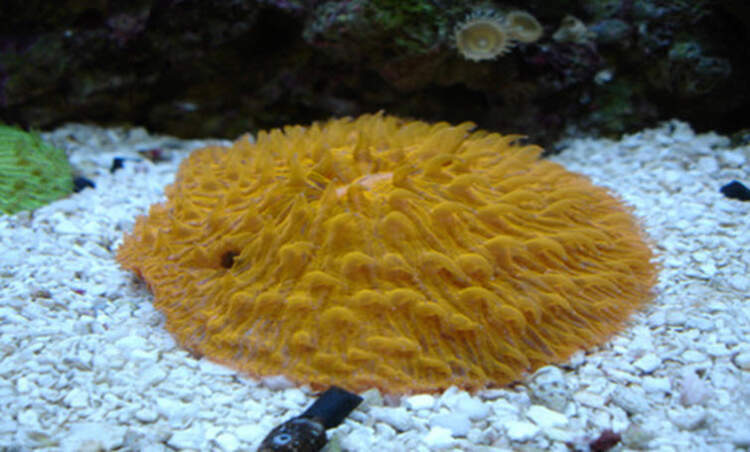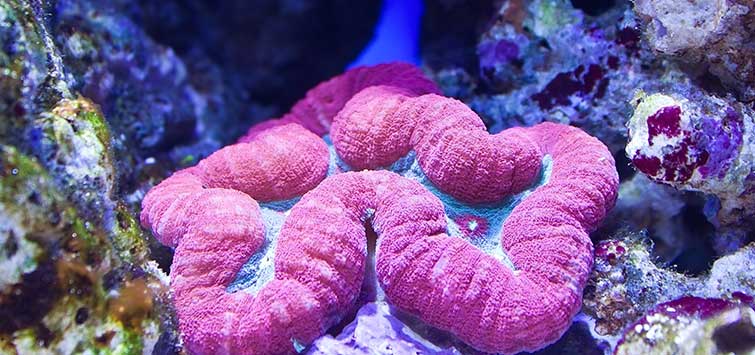Discosoma coerula (blue) and Discosoma ferrugata (red)
Author: Bob Goemans
Common Names: Mushroom corals, mushrooms, mushroom polyps, disc anemones, false corals
Phylum: Cnidaria
Class: Anthozoa
Order: Corallimorpharia
Family: Discosomatidae
Range: Tropical Indo-Pacific Ocean and East Africa to the Central Pacific Ocean
Natural Environment: These very common polyps are sometimes called soft corals and are usually found encrusting substrates of various kinds in shallow lagoons and tidepools. There are numerous color shades and combinations of colors, however the depicted two species are among
Water Requirements: Calcium 380 to 430 ppm, alkalinity 3.5 meq/l, pH 8.1 to 8.2, specific gravity 1.024 to 1.026, and a temperature range of 72° to 83°F (22° to 28°C).
Captive Care
These mostly photosynthetic animals, which are approximately 2 to 4 inches (5 to 10 cm) in diameter, are among the easiest of the cnidarians to maintain because they do better in somewhat nutrient rich surroundings, require low to medium light intensity, and gentle water movement. They are not true anemones (order Actinaria) nor are they true soft corals (oder Alcyonacea/Octocorallia), or true hard corals (order Scleractinia), though they are all cnidarians.
These more common genus members are usually smooth or ribbed with occasional small bumps. They supplement their food supply with the absorption of dissolved nutrients in the bulk water. And should edible foodstuffs, such as detritus, settle on their upper surface, they may form an onion shape, which helps their cilia move the food items toward the centrally located mouth. Nevertheless, I've found that D. ferrugata seems to prefer being located in a vertical position, such as on the side of a rock. If they are given too much light or become too crowded, they may detach themselves and drift around the aquarium, possibly ending up in an area out of sight where they may waste away.
Reproduction
There are three forms of natural asexual reproduction. "Budding" is a term used when a new polyp develops on the stalk. It often migrates onto some form of adjacent substrate and quickly develops into a clone of the original specimen. "Longitudinal fusion" is another form of multiplication and occurs when the specimen splits in half; this often begins at the central orifice/mouth and extends across the whole disc. The third natural form of propagation is called "pedal laceration," which occurs when the specimen moves over substrate and leaves a small portion of itself attached to the substrate. This small piece then grows into a new clone of the original specimen. Sexual propagation is also a possibility, although not well documented. It is thought that in large colonies the more centrally located polyps are females. They release eggs that in turn make their way through the surrounding smaller male polyps and become fertilized, then move onto adjacent substrates where new polyps/colonies form.
For those who can't wait for nature to take its course, the entire head of the stalk can be cut off and then cut it into several pie-shaped pieces. Those pieces can then be placed in a shallow tray of very coarse sand with gently flowing water across its surface area. In a few days those individual pieces will attach themselves to the substrate particles and, in due time, form new polyps. The cut stalk will regain its original shape, and in the coming months be no different than it was before cutting.
Corals to Pair With
Since these animals are mostly non-aggressive, they can live in harmony with many other types of corals. They are very hardy, disease resistant, and fairly fast growing.
Notes
The taxonomy information that has existed in this order of organisms for a long time has been confusing to say the least. Nevertheless, recent (2003) revisions by noted British marine biologist and diver Vincent B. Hargreaves, PhD (doctorate in marine biology with a double major in ichthyology and marine invertebrate zoology) have resulted in a new rearrangement of many of the species known or thought to be in this order. It is now said to encompass three families (Corallimorphidae, Discosomatidae, and Ricordeidae) containing nine genera with 59 species.
Water Requirements: Calcium 380 to 430 ppm, alkalinity 3.5 meq/l, pH 8.1 to 8.2, specific gravity 1.024 to 1.026, and a temperature range of 72° to 83°F (22° to 28°C).

.png?h=595&iar=0&w=2781&hash=5FD5E69473BCC22199FBFA2FB71B6033)



